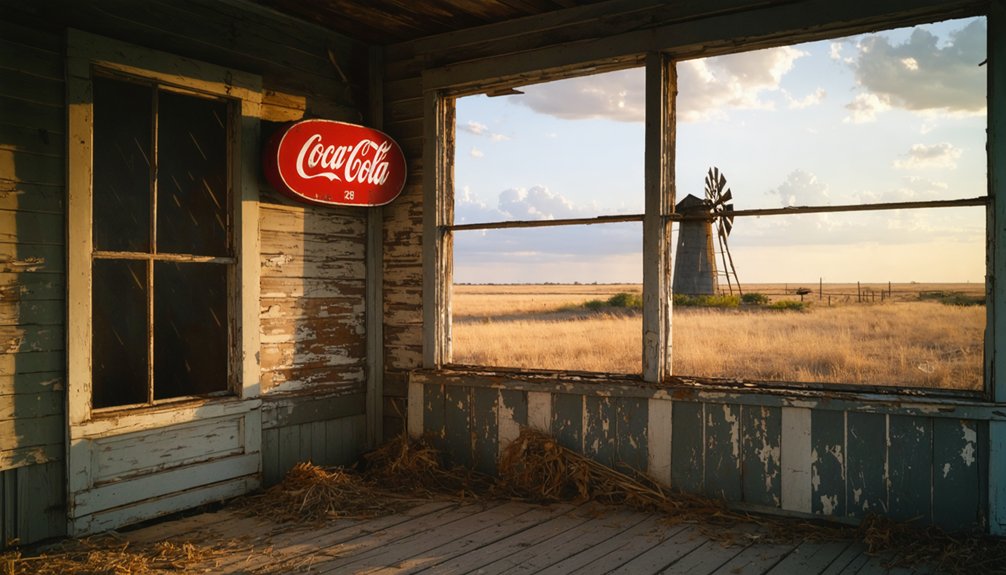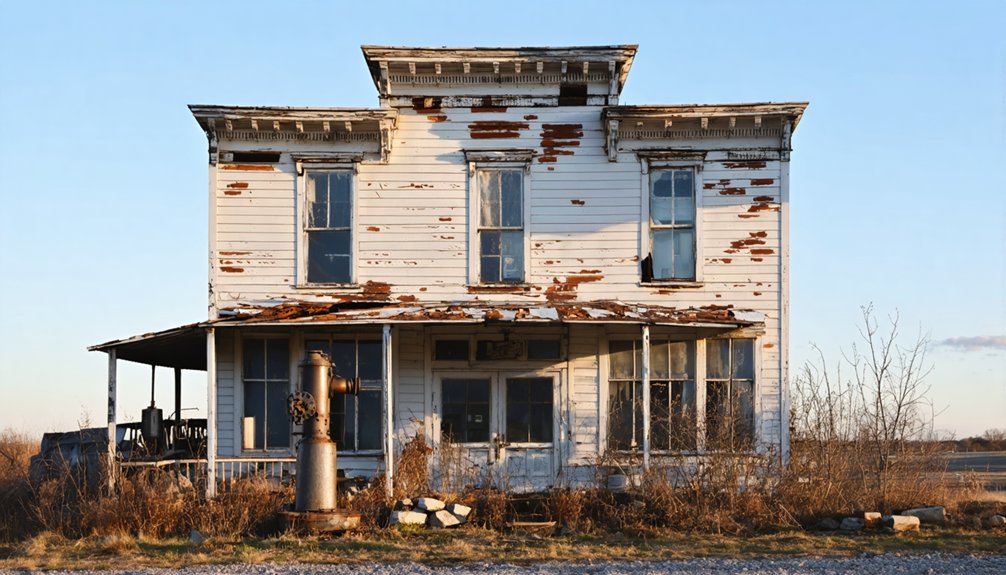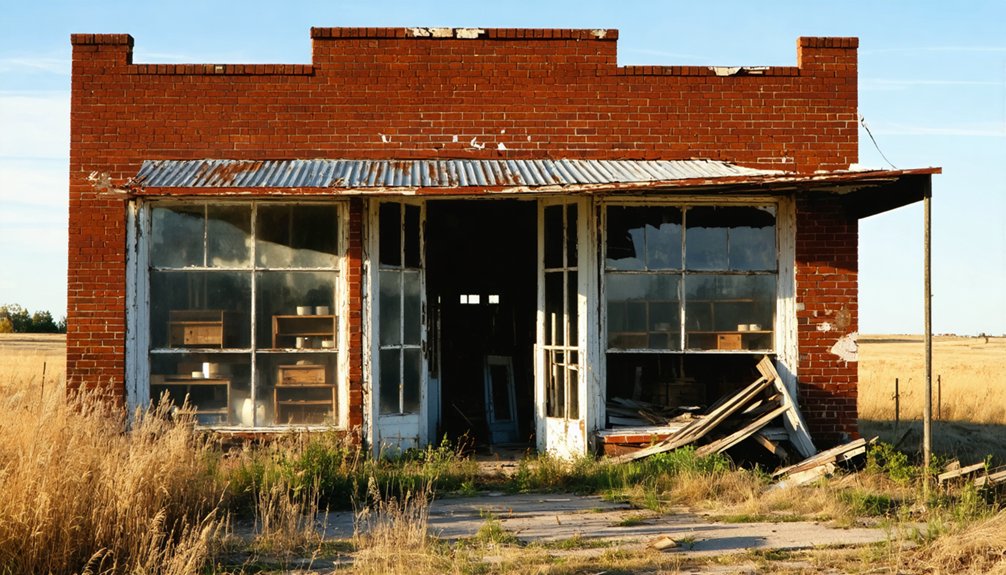You’ll find Texas, Ohio’s ghost town remnants in Henry County’s Washington Township, where it was established in 1849 by the Durbin brothers. The village thrived as a major trading point along the Maumee and Erie Canal, featuring the county’s first brick, barrel, and handle factories. After competing with Napoleon for county seat status, changing transportation routes and economic shifts led to its decline. The site’s rich history holds surprising tales of pioneer resilience and industrial ambition.
Key Takeaways
- Texas, Ohio was a significant village in Henry County established in 1849, strategically located at the junction of Coon Creek and Bad Creek.
- The village thrived due to its location along the Maumee and Erie Canal, hosting the county’s first brick, barrel, and handle factories.
- The Durbin brothers, canal contractors, played a crucial role in Texas’s early development through land investment and infrastructure.
- Texas competed with Napoleon for county seat status during America’s westward expansion between 1880 and 1940.
- Like many canal and railroad-dependent communities, Texas declined when transportation routes changed and resources depleted.
The Rise of Ohio, A Forgotten Texas Settlement
While many historic settlements in Ohio have faded into obscurity, Texas, Ohio once stood as a prominent village in Henry County’s Washington Township.
You’ll find its pioneer struggles began when James and Thomas William Durbin, brothers of Scotch-Irish descent from Maryland, invested in vast tracts of land at the junction of Coon Creek and Bad Creek.
The settlement dynamics shifted dramatically after James Durbin officially recorded the village’s name on April 2, 1849. Texas quickly emerged as a significant trading point, challenging Napoleon for county seat status. Similar to many settlements between 1880 and 1940, the town experienced significant growth during America’s westward expansion.
After officially naming Texas in 1849, the village rapidly grew into a formidable trading hub rivaling Napoleon’s prominence.
The village’s strategic location along the Maumee and Erie Canal fueled its growth, supporting essential industries including the county’s first brick factory, a barrel factory, and a handle factory. Like Cincinnati, Texas, which was established as the furthest navigable point on the Trinity River, the village’s waterway access proved vital to its early development.
The Durbin brothers’ work as canal contractors further cemented the town’s early success.
Early Pioneers and Agricultural Foundations
In 1877, you’d find William T. Baker establishing Ohio’s first permanent settlement along Plum Creek, where he built a cotton gin and general store to serve the emerging farming community.
You’ll note how Baker’s pioneering efforts attracted other settlers who developed surrounding lands for cotton cultivation and cattle ranching, creating a diversified agricultural economy typical of Central Texas frontier life.
The settlement patterns followed familiar pioneer strategies as families positioned their homesteads near water sources and clustered their residences close to Baker’s store and gin, which served as the town’s commercial hub. Like many of Ohio’s ghost towns and settlements, the area would eventually face significant changes that transformed its landscape and community structure. Following the tradition of recording regional development, the Hamilton County Commission documented these early settlement patterns in their comprehensive historical accounts.
Pioneer Settlement Patterns
Three distinct migration streams shaped Ohio’s pioneer settlement patterns in the late 18th and early 19th centuries.
You’d have found New Englanders and New Yorkers moving in via Lake Erie and Zane’s Trace, while settlers from mid-Atlantic and southern states arrived through Kentucky and the Ohio River. The Connecticut Firelands drew specific groups seeking compensation for Revolutionary War losses. The Northwest Ordinance established guidelines for surveying and settling these territories.
These pioneer migration patterns reflected diverse cultural backgrounds.
You’d have encountered English, Scots-Irish, Scottish, and German settlers spreading across the landscape. They brought unique settlement styles, with Upland Southerners favoring dispersed homesteads rather than clustered villages. Swedish and Finnish pioneers introduced practical innovations like log cabins and split-rail fences. Early settlers faced considerable risks from Indian attacks which initially influenced their settlement choices.
First Farming Communities
Early Ohio settlers faced four essential agricultural challenges when establishing their first farms: clearing dense forests, selecting suitable crops, protecting livestock, and developing basic infrastructure.
You’d find these pioneers first clearing dense forest land, girdling large trees and burning brush before they could plant their first crops. They’d start with pioneer crops like corn, buckwheat, and potatoes for survival, while establishing apple orchards and tapping maple trees for sugar. Many of these early farmers were professional land clearers who would move on to clear new areas once their work was complete.
Livestock management meant primarily raising pigs at first, as they required minimal care, though wolves posed constant threats. You’d see oxen working alongside settlers, helping clear land and haul logs for rail fences and log cabins. The Native Americans had already developed successful farming methods using The Three Sisters cultivation of corn, beans, and squash that some settlers adopted.
Frontier Life Challenges
Beyond the initial task of establishing farms, pioneers in Ohio and Texas endured formidable challenges that shaped their daily existence. You’d have faced frontier hardships that tested your resilience daily, from harsh winters to conflicts with Native American tribes. The Seaboard land policy prioritized individual farmer ownership, providing both independence and voting rights.
The agricultural inefficiencies of early settlement meant you couldn’t rely on sophisticated farming methods, often leading to quick land exhaustion and the need to relocate. Self-governing communities emerged as settlers developed local frameworks for defense and organization away from established colonial authorities.
- Clearing small patches of virgin land while leaving vast areas in timber
- Letting livestock forage freely in forests due to poor pasture management
- Struggling with basic irrigation and depending heavily on natural water sources
- Managing limited tools and resources while adapting to unfamiliar climates
These challenges fostered a spirit of self-reliance and community bonds that would define frontier settlements for generations to come.
Railroad Dreams and Economic Reality
You’ll find that both Ohio’s Moonville and Texas’s Tascosa exemplify how railroad access could rapidly transform remote locations into bustling commercial hubs in the late 1800s.
While Moonville’s coal shipments and Tascosa’s cattle trade flourished with rail connections, neither town could survive when their single-industry economies faltered.
The stark reality of these railroad towns emerged when changing routes and depleted resources left behind empty buildings and abandoned rail beds, marking the end of their brief but vibrant existence.
Rapid Rise and Fall
While railroad expansion promised prosperity across Ohio and Texas in the late 1800s, many small towns built on these dreams would ultimately fade into obscurity.
Economic speculation drove rapid settlement as railroads carved paths through resource-rich territories. You’ll find stories of community resilience in places like Moonville, Ohio, where coal mining supported a population of 100, and Verhalen, Texas, where agricultural prospects drew hopeful settlers.
- Railroad companies donated land and built stations, fueling expectations of lasting growth
- Towns emerged around single industries – mining in Ohio, farming in Texas
- Natural resource depletion and changing market conditions sparked rapid decline
- Loss of rail service isolated communities, accelerating their abandonment
These boom-and-bust cycles left behind empty buildings and dismantled infrastructure, transforming vibrant communities into historical footnotes within a generation.
Rail Access Proved Essential
Railroad tracks formed the economic lifelines for communities like Ohio, Texas and Moonville, Ohio during the late 1800s.
You’ll find that towns with direct rail connections thrived initially, supporting crucial commerce hubs like cotton gins, stores, and post offices that kept communities sustainable.
In Ohio, TX, settlers like William T. Baker built businesses that depended on rail freight and passenger services along Plum Creek.
But you can see how fragile these rail-dependent economies were – when the post office relocated to another mill town in 1886, it signaled the beginning of decline.
Without strong rail connections, economic sustainability became impossible. The town’s population stagnated at just 20 residents through the 1930s and 1940s, and its last business closed in 1943, showing how critical railroad access was to survival.
Daily Life in a Texas Prairie Town

Life in a Texas prairie town revolved around three key activities: farming, ranching, and community gatherings. You’d find settler traditions deeply woven into daily routines, from tending cotton fields to managing livestock on the open range.
From sunup to sundown, prairie life centered on working the land, raising cattle, and coming together as neighbors.
Prairie education started in one-room schoolhouses, where the community’s children would gather to learn their lessons.
- Churches served as social hubs, with two established by 1890
- General stores provided essential supplies and served as meeting spots
- Families worked together in broom and wagon factories
- Local newspapers kept everyone connected to community happenings
Your daily activities would’ve centered around agriculture, but you’d also find time for community events.
As transportation improved with graveled roads and railway connections, you’d have more opportunities to travel between settlements and engage in trade with neighboring towns.
Natural Disasters and Population Decline
Throughout the late 1800s, natural disasters struck Ohio and Texas towns with devastating consequences, setting off chains of decline that would create dozens of ghost towns.
You’ll find that Providence, Ohio suffered a major fire in 1846, followed by a cholera outbreak in 1854, while Texas prairie towns battled harsh droughts and floods that crippled agriculture.
The disaster impact went beyond immediate destruction. When mines flooded or burned in Ohio towns like Moonville, you’d see rapid population shifts as workers fled.
Similarly, Texas farmers abandoned their lands when agricultural viability vanished. Without economic anchors, these isolated communities couldn’t sustain basic services.
Towns beyond commuting distance to major cities faced the steepest declines, and by the mid-1900s, many had become shells of their former selves.
Remnants and Historical Landmarks Today

While many Ohio ghost towns have vanished entirely, several compelling remnants still dot the landscape today, particularly in the southeastern region of the state.
You’ll discover historical markers throughout these abandoned settlements, with Moonville’s brick tunnel standing as one of the most iconic structures. The area’s rich mining heritage lives on through scattered industrial remains and old railway infrastructure, while ghostly legends continue to draw curious visitors year after year.
- The Moonville Tunnel, accessible via hiking trails in Zaleski State Forest, serves as a memorial to the region’s railroad era
- Former mining towns like Belmont showcase remnants of coal mining equipment and infrastructure
- Local cemeteries preserve the memory of early settlers and mining communities
- Restored walkways and bridges now allow safe exploration of these historic sites
Local Legends and Cultural Legacy
Ghost towns across Ohio and Texas have spawned rich tapestries of supernatural lore, with each abandoned settlement harboring its own distinct legends.
In Ohio, you’ll find ghostly apparitions at Moonville Tunnel, where a tragic death spawned stories of a spectral figure haunting the tracks. The Dent Schoolhouse draws thousands seeking the spirit of Charlie McFee, while Rogues Hollow echoes with tales of a headless horseman and crying babies.
Texas offers its own haunted sites, where you can chase the Phantom Motorcyclist of Lebanon or explore abandoned structures where former residents supposedly still linger.
Local folklore tells of mysterious “small folks” in Munchkinville, while outlaw hideouts fuel stories of restless bandits.
These legends keep the memory of these forgotten places alive, drawing curious visitors and paranormal enthusiasts year after year.
Frequently Asked Questions
How Did Ohio, Texas Get Its Unusual Name?
You’ll find this historic significance: James Durbin named his Ohio settlement “Texas” in 1849, likely inspired by admiration for Texas’s frontier spirit, though the exact naming origins remain symbolic rather than direct.
Were There Any Famous Outlaws or Gunfights in Ohio, Texas?
Like a dusty blank page in history’s book, you won’t find any famous outlaw legends or documented gunfight history in this small community, despite Texas’s wider reputation for Wild West action.
What Native American Tribes Originally Inhabited the Ohio, Texas Area?
You’ll find the Shawnee, Miami, Wyandot, and Ottawa originally inhabited Ohio, while Texas was home to the Comanche, Apache, and Caddo tribes. These Native tribes left significant historical legacies.
Did Any Hollywood Movies Ever Feature Ohio, Texas as a Location?
You won’t find any Hollywood movies featuring Ohio, Texas, as this intriguing location isn’t documented in either Ohio movies or Texas films – it’s a mysterious place that’s eluded the silver screen.
Which Families From the Original Settlement Still Live Nearby Today?
You won’t find any original settlers living nearby today, though the Smith and Hunter families maintain ownership rights to Cincinnati’s site, preserving their family heritage but not residing as local descendants.
References
- https://www.heraldtimesonline.com/story/lifestyle/home-garden/2020/05/01/ghost-towns-in-ohio-and-indiana/43807535/
- https://www.homestratosphere.com/boom-bust-towns-ohio/
- https://www.youtube.com/watch?v=QWTtG6njIDs
- https://ohiohome.org/news/documents/GhostTowns.pdf
- https://wrkr.com/ohio-ghost-towns/
- http://projects.thepostathens.com/SpecialProjects/ohios-hidden-history-ghost-towns-mining/
- https://ohioghosttowns.org/top-10-ghost-towns/
- https://en.wikipedia.org/wiki/List_of_ghost_towns_in_Ohio
- https://ohioghosttowns.org/county-data-charts/
- https://www.ohiotraveler.com/moonville-its-a-ghost-town/



